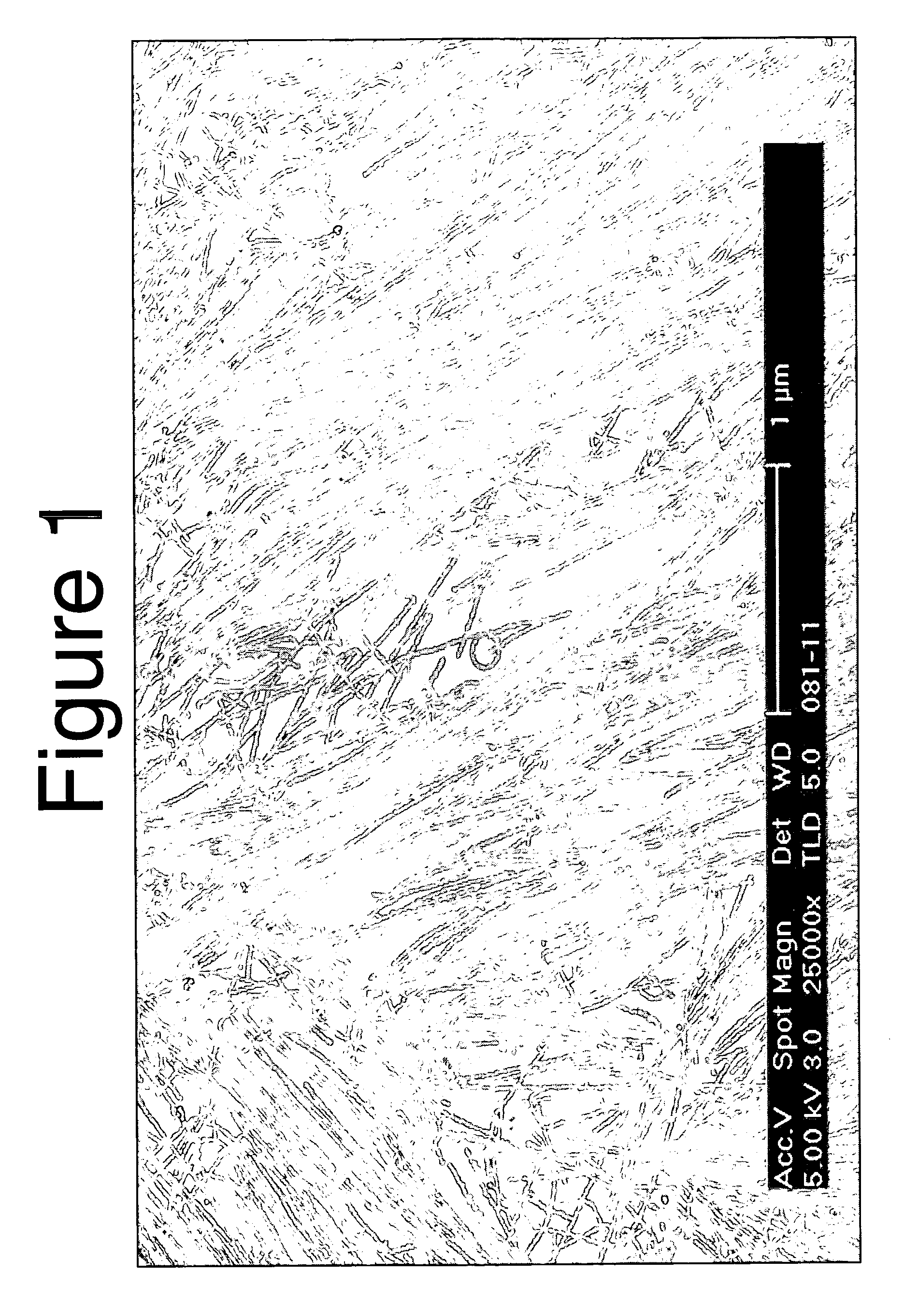Aqueous carbon nanotube applicator liquids and methods for producing applicator liquids thereof
a carbon nanotube and applicator liquid technology, applied in the field of application liquids, can solve the problems of difficult derivatizing agent removal, difficult to remove derivatizing agent, and difficult to include or incorporate swnt as part of standard microelectronic fabrication process
- Summary
- Abstract
- Description
- Claims
- Application Information
AI Technical Summary
Benefits of technology
Problems solved by technology
Method used
Image
Examples
example 1
[0068] This example describes the purification of nanotubes.
[0069] Single-walled carbon nanotubes (SWNTs) were purified by mixing 1 g of carbon nanotubes with a 125 mL:125 mL mixture of 15 M nitric acid (HNO3):DI water. The nanotube:nitric acid:DI mixture was stirred for 8 hours and refluxed for 12 hours at 125° C. After purification, the 250 mL nanotube:nitric acid solution was diluted with 7 parts DI water (˜1.8 L). The pH of the solution was adjusted to 1.5±0.1 by dropwise addition of concentrated NH4OH ([c]˜35%). The solution was then sonicated for 60 minutes in a chilled sonication bath at 4-5° C. Once sonication was completed, cross-flow filtration was then performed with a dedicated 0.5 micron ceramic membrane. The filtration was performed until the liquid that passes through the pores of the filter membrane obtained a pH of 4.0. This liquid is called a permeate and was rejected. The liquid that does not pass through the pores of the filter membrane is called a retentate and...
example 2
[0073] In addition to the examples given above, various pre-oxidation schemes were also used to purify the carbon nanotubes. Without being bound to theory, pre-oxidation process may remove amorphous carbon impurities and also may crack open the graphitic shells that cover the metal catalysts, thereby rendering them accessible to subsequent acid treatment.
[0074] In one example, carbon nanotubes were purified by mixing 1 g of carbon nanotubes with 100 mL of 30% H2O2. The nanotube:hydrogen peroxide was refluxed for 3 h at 110° C. After the pre-oxidation step, the 100 mL nanotube:peroxide solution was diluted with 10 parts DI water (˜1L). The nanotube:peroxide:DI water slurry was sonicated for 60 minutes in a chilled sonication bath at 4-5° C. The slurry was then vacuum filtered over 5 micron Teflon filter membrane. The solid was collected from the top of the filter membrane and taken through the next processing steps, as described below.
[0075] After the pre-oxidation step described a...
example 3
[0078] This example describes a gas phase pre-oxidation of carbon nanotubes. For example, 1 g of carbon nanotubes were heated in a flow of nitrogen-oxygen mixture (2:1 ratio) at 350° C. for 12 h. The gas-phase pre-oxidized carbon nanotube material was taken through the nitric acid treatment, cross flow filtration and centrifugation steps as described in Example 2 to produce an applicator liquid.
[0079] The applicator liquid produced herein can also be used to form a component of NRAM memories, such as described in U.S. Pat. No. 6,919,592, entitled “Electromechanical Memory Array Using Nanotube Ribbons and Method for Making Same,” filed Jul. 25, 2001; U.S. Pat. No. 6,643,165, entitled “Electromechanical Memory Having Cell Selection Circuitry Constructed with Nanotube Technology,” filed Jul. 25, 2001; U.S. patent application Ser. No. 10 / 810,962, entitled “NRAM Bit Selectable Two-Drive Nanotube Array,” filed Mar. 26, 2004; and U.S. patent application Ser. No. 10 / 810,963, entitled “NRAM...
PUM
 Login to View More
Login to View More Abstract
Description
Claims
Application Information
 Login to View More
Login to View More - R&D
- Intellectual Property
- Life Sciences
- Materials
- Tech Scout
- Unparalleled Data Quality
- Higher Quality Content
- 60% Fewer Hallucinations
Browse by: Latest US Patents, China's latest patents, Technical Efficacy Thesaurus, Application Domain, Technology Topic, Popular Technical Reports.
© 2025 PatSnap. All rights reserved.Legal|Privacy policy|Modern Slavery Act Transparency Statement|Sitemap|About US| Contact US: help@patsnap.com



